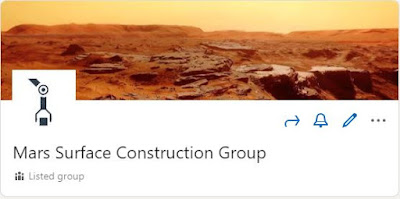Mars Surface Construction
#ISPP #InsituPropellantProduction #ISRU
#InSituResourceUtilization #mars #marsexploration #autonomoussystems #automation #civilengineering #civilengineeringdesign #roboticconstruction #robotics
After the successful flight of the Starship, Mars missions
in the transfer orbit windows are much more real than a year ago. Early
uncrewed starship missions to Mars will need to establish infrastructure for
human exploration. SpaceX will focus mostly on the cargo delivery part. Some of
the payloads might need to be ready for the 2024 launch window.
The need for robotic in-situ resource use is essential. This discussion should support the process of
creating specifications, designs, and simulations of crucial systems. Eventually, the goal is to develop prototypes
- proof of concept cyber-physical systems that can be tested on Earth.
There is a rather significant interest in research and
engineering communities, which resulted in papers, conference presentations,
simulations, and other early proof of concept work.
At this point, the main topics of interests are:
-
Software: from construction scheduling to
autonomous AI
-
Robotics systems, vehicles, specialized tooling
-
Assembly processes of payload elements
o
Energy sources,
o
ISPP (In-situ Propellant Production), ISRU (In-Situ
Resource Utilization) equipment
o
Power grid development,
o
fuel storage)
- In-situ material acquisition processes
The Construction Industry and Mars
https://www.linkedin.com/feed/update/urn:li:activity:6743662480142209024
The construction industry is increasingly using automation
for the hard labor that goes into construction. There are many reasons, e.g.,
labor shortages, the dangerous nature of work, and economic pressures, to name
only a few.
There is an additional reason for automation to become
increasingly important. It is related to the successful Starship demo flight by
SpaceX.
After the successful flight of the Starship, Mars missions
in the transfer orbit windows are much more real than a year ago. Early
uncrewed starship missions to Mars will need to establish infrastructure for
human exploration. SpaceX will focus mostly on the cargo delivery part. Some of
the payloads might need to be ready for the 2024 launch window.
The need for robotic in-situ resource use is essential. This discussion should support the process of
creating specifications, designs, and simulations of crucial systems. Eventually, the goal is to develop prototypes
- proof of concept cyber-physical systems that can be tested on Earth.
Source:
https://fortune.com/2019/11/23/construction-industry-robots-ai/
Such companies as Build Robotics, Toggle, Doxel, Dusty
Robotics, EKSO Bionics, or FBR offer automated construction systems. Are
they going to participate in the early Mars projects? Those projects will need
to build essential infrastructure on Mars in the following broad areas:
-
Power generation and power grid
-
Resource acquisition processes, i.e., ISRU (In-Situ
Resource Utilization)
-
Propellant production
-
Energy storage
- Robotic equipment maintenance
These are the essential areas before humans arrive on the
red planet. The fuel necessary for the return trip has to be produced on Mars.
Fuel production is a very power-intensive process that requires significant
mining capabilities to reach the key raw material - water stored underground.
The good news is that all elements needed to produce the propellant (methane
and oxygen) are on Mars. The science of how to do it has been demonstrated and
it works.
Now all the R&D has to be delivered to Mars and put together…





No comments:
Post a Comment
Note: Only a member of this blog may post a comment.